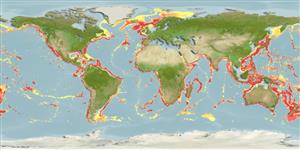Environment: milieu / climate zone / profondeur / distribution range
Écologie
marin bathydémersal; profondeur 120 - 2000 m (Ref. 50610). Deep-water
Throughout the world ocean in tropical and temperate latitudes (Ref. 9842). Eastern Atlantic: one specimen from off Cape Bojador south of the Canary Islands; unrecorded specimens taken between Guinea and Angola. Western Atlantic: Canada (Ref. 5951) to the Gulf of Mexico (Ref. 29076). Western Indian Ocean: off Madagascar. Eastern Pacific: one specimen captured off northern central California, USA (Ref. 2850). Western Pacific: Japan to New Caledonia, Australia (Ref. 7300) and New Zealand (Ref. 5755).
Taille / Poids / Âge
Maturité: Lm ? range ? - ? cm
Max length : 39.0 cm TL mâle / non sexé; (Ref. 5951)
Description synthétique
Clés d'identification | Morphologie | Morphométrie
Épines dorsales (Total) : 0; Rayons mous dorsaux (Total) : 19 - 22; Épines anales: 0; Rayons mous anaux: 15 - 18. Mouth large, maxillary extending far beyond eye (Ref. 559) Lower jaw projecting beyond the upper (Ref. 559). Teeth on both jaws broad villiform bands (Ref. 559). Body and each fin with minute spinules, the surface velvety to the touch. Lateral line opening as distinct pores (Ref. 559).
Body shape (shape guide): fusiform / normal; Cross section: compressed.
Juveniles mesopelagic, adults benthopelagic. Presumably feed on crustaceans.
Life cycle and mating behavior
Maturité | Reproduction | Frai | Œufs | Fécondité | Larves
Paxton, J.R. and D.J. Blake, 1990. Barbourisiidae. p. 606. In J.C. Quero, J.C. Hureau, C. Karrer, A. Post and L. Saldanha (eds.) Check-list of the fishes of the eastern tropical Atlantic (CLOFETA). JNICT, Lisbon, SEI, Paris; and UNESCO, Paris. Vol. 2. (Ref. 4500)
Statut dans la liste rouge de l'IUCN (Ref. 130435: Version 2025-1)
Menace pour l'homme
Harmless
Utilisations par l'homme
Pêcheries: sans intérêt
Outils
Articles particuliers
Télécharger en XML
Sources Internet
Estimates based on models
Preferred temperature (Réf.
123201): 3 - 12.3, mean 7.1 °C (based on 2015 cells).
Phylogenetic diversity index (Réf.
82804): PD
50 = 1.5000 [Uniqueness, from 0.5 = low to 2.0 = high].
Bayesian length-weight: a=0.01122 (0.00514 - 0.02450), b=3.04 (2.87 - 3.21), in cm total length, based on all LWR estimates for this body shape (Ref.
93245).
Niveau trophique (Réf.
69278): 3.3 ±0.41 se; based on food items.
Fishing Vulnerability (Ref.
59153): Low to moderate vulnerability (29 of 100).
🛈
Nutrients (Ref.
124155): Calcium = 32.8 [16.5, 71.2] mg/100g; Iron = 0.573 [0.294, 1.067] mg/100g; Protein = 17.1 [15.9, 18.3] %; Omega3 = 0.52 [0.27, 0.97] g/100g; Selenium = 28 [13, 60] μg/100g; VitaminA = 7.76 [1.87, 31.35] μg/100g; Zinc = 0.499 [0.344, 0.736] mg/100g (wet weight);
